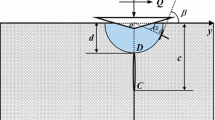Abstract
Grinding of brittle materials will inevitably cause grinding damages characterized by fracture microcracks, which will greatly affect the grinding integrity. Traditional damage models are just concerned about the material properties and interaction depth between grit and workpiece without considering the dynamic effect on material strength. This paper proposed new damage analysis models which consider the effect of both strain rate and grinding parameters on grinding damages. It is believed that the material strength and dynamic fracture toughness vary under different grinding parameters due to the variation of strain rate brought by the grinding speed and chip thickness. By introducing the grinding-induced strain rate, the new damage models were further updated as the function of the grinding speed and chip thickness. The grinding damage models were verified through different grinding tests. Combining with the surface roughness results, the grinding damages under different grinding speed and damages are fully discussed. Finally, the damage-free grinding was proposed based on the proposed model. It can be concluded that a combination of the grinding speed and reduction of the chip thickness can help achieve damage-free ground surface.
Similar content being viewed by others
References
Agarwal S, Rao PV (2011) Improvement in productivity in SiC grinding ProcIMechE Part B. J Eng Manuf 225(B6):811–830
Chongjun W, Beizhi L, Jingzhu P, Liang SY (2016) Ductile grinding of silicon carbide in high speed grinding. Journal of Advanced Mechanical Design, Systems, and Manufacturing 10:2
Chongjun Wu, Beizhi Li, Jianguo Yang and Steven Y Liang (2016). Prediction of grinding force for brittle materials considering co-existing of ductility and brittleness. Int J Adv Manufact Tech. 1–9. doi: 10.1007/s00170-016-8594-4.
Brinksmeier E, Mutlugünes Y, Klocke F, Aurich JC, Shore P, Ohmori H (2010) Ultra-precision grinding. CIRP Ann Manuf Technol 59(2):652–671
Yue C, Liu X, Ma J, Liu Z, Liu F, Yang Y (2014) Hardening effect on machined surface for precise hard cutting process with consideration of tool wear. Chinese J Mech Eng 27(6):1249–1256
Li B, Ni J, Yang J, Liang SY (2014) Study on high-speed grinding mechanisms for quality and process efficiency. Int J Adv Manuf Technol 70(5–8):813–819
Malkin S, Hwang TW (1996) Grinding mechanisms for ceramics. CIRP Ann Manuf Technol 45(2):569–580
Li HN, Yu TB, Zhu LD, Wang WS (2016) Evaluation of grinding-induced subsurface damage in optical glass BK7. J Mater Process Technol 229:785–794
Lawn BR, Evans AG, Marshall DB (1980) Elastic/plastic indentation damage in ceramics: the median/radial crack system. J Am Ceram Soc 63:574–581
Lambropoulos JC, Fang T, Funkenbusch PD, Jacobs SD, Cumbo MJ, Golini D (1996) Surface micro roughness of optical glasses under deterministic microgrinding. Appll Opt 35(22):4448–4462
Li SY, Wang Z, Wu YL (2008) Relationship between subsurface damage and surface roughness of optical materials in grinding and lapping processes. J Mater Process Technol 205:34–41
Yao ZQ, Gua WB, Li KM (2012) Relationship between surface roughness and subsurface crack depth during grinding of optical glass BK7. J Mater Process Technol 212:969–976
Gu W, Yao Z, Li K (2011) Evaluation of subsurface crack depth during scratch test for optical glass BK7. ProcIMechE, Part C. J Mech Eng Sci 225(12):2767–2774
Lin XH, Ke XL, Ye H, Hu CL, Guo YB (2016) Investigation of surface/subsurface integrity and grinding force in grinding of BK7 glass ProcIMechE Part C. J Mech Eng Sci 0954406216631575
Ramesh K, Huang H (2006) Use of wheel speed as a parameter to inhibit surface crack generation in the grinding of wear-resistant fillers. Int J Adv Manuf Technol 28:701–706
Wang CC, Fang QH, Chen JB, Liu YW, Jin T (2016) Subsurface damage in high-speed grinding of brittle materials considering kinematic characteristics of the grinding process. Int J Adv Manuf Technol. doi:10.1007/s00170-015-7627-8
Ravichandran G, Subhash G (1995) A micromechanical model for high strain rate behavior of ceramics. Int J Solids Struct 32((17, 18)):2627–2646
Hall IW, Guden M (1998) High strain rate behavior of a SiC particulate reinforced Al2O3 ceramic matrix composite. Scr Mater 38(4):667–674
Jing X, Maiti S, Subhash G (2007) A new analytical model for estimation of scratch-induced damage in brittle solids. J Am Ceram Soc 90(3):885–892
Zhu D, Yan S, Li B (2014) Single-grit modeling and simulation of crack initiation and propagation in SiC grinding using maximum undeformed chip thickness. Comput Mater Sci 92:13–21
Chongjun W, Beizhi L, Jianguo Y, Liang SY (2016) Experimental investigations of machining characteristics of SiC in high speed plunge grinding. J Ceram Process Res 17(3):223–231
Malkin S (1989) Grinding technology, theory and applications of machining with abrasives. Ellis Horwood Limited, Chichester
Lin S, Yang S, Lin Y, Zhao P, Wu P, Jiang Z (2015) A new model of grinding forces prediction for machining brittle and hard materials. Procedia CIRP 27:192–197
Liu Y, Li B, Wu C, Zheng Y (2015) Simulation-based evaluation of surface micro-cracks and fracture toughness in high-speed grinding of silicon carbide ceramics. Int J Adv Manuf Technol. doi:10.1007/s00170-015-8218-4
Pan Z, Liang SY, Garmestani H, Shih DS (2016) Prediction of machining-induced phase transformation and grain growth of Ti-6Al-4 V alloy. Int J Adv Manuf Technol. doi:10.1007/s00170-016-8497-4
Lankford J (1981) Mechanisms responsible for strain-rate-dependent compressive strength in ceramic materials. J Am Ceram Soc 64(2):C-33–C-34
Bifano TG, Dow TA, Scattergood RO (1991) Ductile-regime grinding: a new technology for machining brittle materials. J Eng Ind Trans ASME 113(2):184–189
Ding Z, Li B, Liang SY (2015) Maraging steel phase transformation in high strain rate grinding. Int J Adv Manuf Technol 80:711–718
Author information
Authors and Affiliations
Corresponding author
Rights and permissions
About this article
Cite this article
Wu, C., Li, B., Liu, Y. et al. Strain rate-sensitive analysis for grinding damage of brittle materials. Int J Adv Manuf Technol 89, 2221–2229 (2017). https://doi.org/10.1007/s00170-016-9237-5
Received:
Accepted:
Published:
Issue Date:
DOI: https://doi.org/10.1007/s00170-016-9237-5



